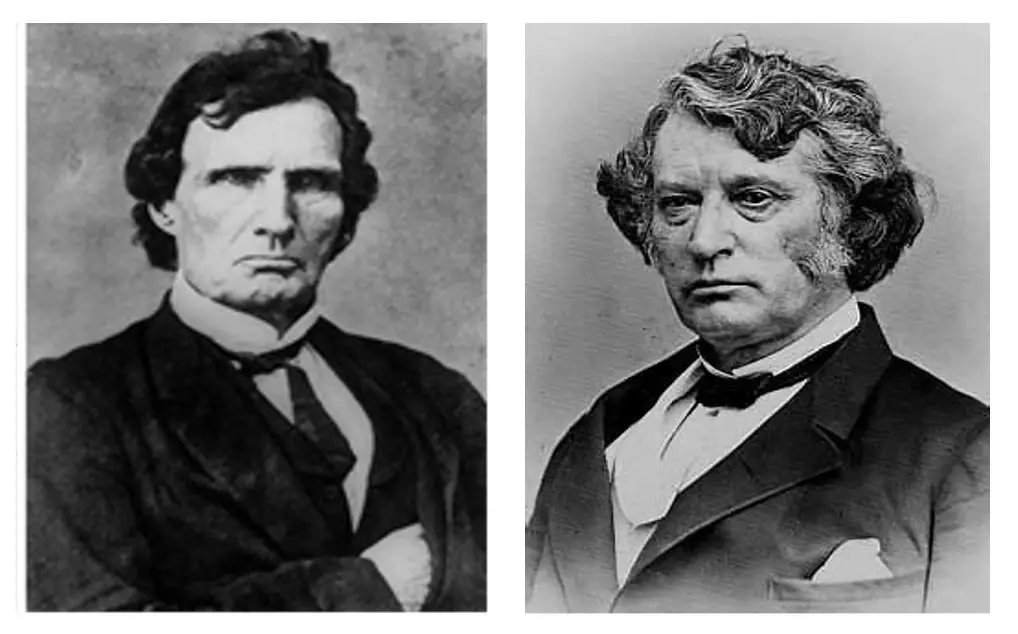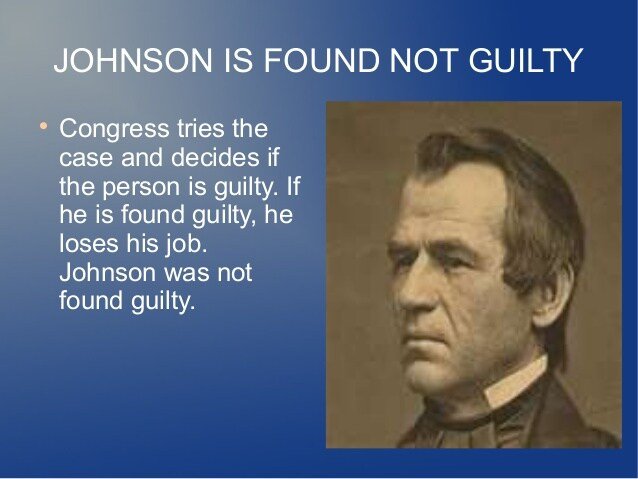The Impeachment Of President Johnson
President Johnsons relentless vetoing of congressional measures created a deep rift in Washington, DC, and neither he nor Congress would back down. Johnsons prickly personality proved to be a liability, and many people found him grating. Moreover, he firmly believed in white supremacy, declaring in his 1868 State of the Union address, The attempt to place the white population under the domination of persons of color in the South has impaired, if not destroyed, the kindly relations that had previously existed between them; and mutual distrust has engendered a feeling of animosity which leading in some instances to collision and bloodshed, has prevented that cooperation between the two races so essential to the success of industrial enterprise in the southern states. The presidents racism put him even further at odds with those in Congress who wanted to create full equality between blacks and whites.
This illustration by Theodore R. Davis, which was captioned The Senate as a court of impeachment for the trial of Andrew Johnson, appeared in Harpers Weekly in 1868. Here, the House of Representatives brings its grievances against Johnson to the Senate during impeachment hearings.
The Legislation Passed By The Radical Republicans
Q8. Identify the legislation passed by the Radical Republicans in Congress in the 1860s that protected the rights of African Americans. Include in your analysis whether or not the legislations objectives were met?
Q9.Why were African Americans unable to secure equal rights during Reconstruction?
A. The Political Contest over Reconstruction
1. When Andrew Johnson assumed the presidency after Abraham Lincoln was assassinated, he maintained Lincolns lenient policies toward former Confederates. Radical Republicans were angered by the fact that Johnson quickly restored civil governments in Confederate states, granted amnesty to former Confederates, and displayed no concern for protecting the civil rights of freedpeople.
2. During the Civil War, Republicans led by Representative Thaddeus Stevens and Senator Charles Sumner had pressed for more aggressive military campaigns and a quicker end to slavery. These Republicans also introduced the Wade-Davis Bill, which was designed to reverse leniency toward Confederates.
3. In December 1865, Johnson announced that the Union was restored, and Radical Republicans were alarmed by the fact that representatives and senators from former Confederate states were slated to be reseated in Congress. Radical Republicans responded by forming a joint committee to examine issues of suffrage and representation for the former Confederate states.
B. Black Reconstruction
C. The Defeat of Reconstruction
The Radical Republicans Take Control
Northern voters spoke clearly in the Congressional election of 1866. Radical Republicans won over two-thirds of the seats in the House of Representatives and the Senate. They now had the power to override Johnson’s vetoes and pass the Civil Rights Act and the bill to extend the Freedmen’s Bureau, and they did so immediately. Congress had now taken charge of the South’s reconstruction.
Read Also: Breakdown Of Trump Voters
An African American Majority In The South Carolina Legislature
Because blacks in South Carolina vastly outnumbered whites, the newly-enfranchised voters were able to send so many African American representatives to the state assembly that they outnumbered the whites. Many were able legislators who worked to rewrite the state constitution and pass laws ensuring aid to public education, universal male franchise, and civil rights for all.
Bookmark this item: //www.loc.gov/exhibits/african-american-odyssey/reconstruction.html#obj12
New Opportunities For African Americans

The Radical Republicans’ reconstruction offered all kinds of new opportunities to African-American people, including the vote , property ownership, education, legal rights, and even the possibility of holding political office. By the beginning of 1868, about 700,000 African Americans were registered voters. Fourteen African-American people held seats in the U.S. House of Representatives, and many others took their places in state legislatures.
Unfortunately, however, this new way of life was not to last. By the mid-1870s, a resurgence of Southern Democrats was undermining the Radical Republican effort. Democrats were slowly reasserting their control in the South and firmly relegating African-American citizens to their former subordinate positions. In the end, the Radical Republicans lost the Reconstruction’s battle of ideas, but the real losers were African-American people, whose newly gained rights quickly slipped away.
Recommended Reading: Can The Democrats Stop Trump
African American Population Distribution 1890
African American population distribution and migration patterns can be traced using maps published in the statistical atlases prepared by the U. S. Census Bureau for each decennial census from 1870 to 1920. The atlas for the 1890 census includes this map showing the percentage of colored to the total population for each county. Although the heaviest concentrations are overwhelmingly in Maryland, Virginia, and the southeastern states, there appear to be emerging concentrations in the northern urban areas , southern Ohio, central Missouri, eastern Kansas, and scattered areas in the West , reflecting migration patterns that began during Reconstruction.
African American Men In Government
The Fifteenth Amendment to the U.S. Constitution gave the vote to all male citizens regardless of color or previous condition of servitude. African Americans became involved in the political process not only as voters but also as governmental representatives at the local, state and national level. Although their elections were often contested by whites, and members of the legislative bodies were usually reluctant to receive them, many African American men ably served their country during Reconstruction. Pictured here are Senator Hiram R. Revels and Representatives Benjamin S. Turner, Josiah T. Walls, Joseph H. Rainey, Robert Brown Elliot, Robert D. De Large, and Jefferson H. Long.
Bookmark this item: //www.loc.gov/exhibits/african-american-odyssey/reconstruction.html#obj15
Recommended Reading: How Many Republicans Voted For Obama In 2008
Answer To Review Question
Glimpses Of The Freed Women
Northern teachers, many of whom were white women, traveled into the South to provide education and training for the newly freed population. Schools from the elementary level through college provided a variety of opportunities, from the rudiments of reading and writing and various types of basic vocational training to classics, arts, and theology. This school in Richmond shows women of color learning the fine points of sewing.
James E. Taylor. “The Freedmen’s Union Industrial School, Richmond, Va.” From Frank Leslie’s Illustrated Newspaper, September 22, 1866. Copyprint. , Library of Congress. Reproduction Number: LC-USZ62-33264
Bookmark this item: //www.loc.gov/exhibits/african-american-odyssey/reconstruction.html#obj8
Don’t Miss: Who Is Right Republicans Or Democrats
Radical Republican Reconstruction Plan
The postwar Radical Republicans were motivated by three main factors:
- Liberal land policies for settlers
- Federal aid for railroad development
Brought to you by Online Highways © 2021
The Radical Republicans After The Death Of Thaddeus Stevens
Thaddeus Stevens died on August 11, 1868. After lying in the state in the rotunda of the U.S. Capitol, he was buried in a cemetery in Pennsylvania he had chosen as it allowed burials of both White and Black people.
The faction of Congress he had led continued, though without his fiery temperament much of the fury of the Radical Republicans subsided. Plus, they tended to support the presidency of Ulysses S. Grant, who took office in March 1869.
You May Like: When Will Republicans Do The Right Thing
Freed Persons Receive Wages From Former Owner
Some emancipated slaves quickly fled from the neighborhood of their owners, while others became wage laborers for former owners. Most importantly, African Americans could make choices for themselves about where they labored and the type of work they performed. This account book shows that former slaves who became free workers after the Civil War received pay for their work on Hampton Plantation in South Carolina.
Hampton Plantation Account Book, 18661868. South Carolina. Handwritten manuscript. Page 68 – Page 69. Miscellaneous Manuscript Collection, Manuscript Division, Library of Congress
Bookmark this item: //www.loc.gov/exhibits/african-american-odyssey/reconstruction.html#obj6
The End Of The Movement

- The Radical movement was coming to an end, its agenda superseded by concerns about the economy, which had been hit by recession in 1873.
- In the Congressional elections of 1874, the Democrats took control. Southern State legislatures gradually reverted to the Democrats as well, and the reforms of the Radical Republicans began to be rolled back.
- In the highly controversial 1876 presidential election, Republican Rutherford B. Hayes managed to win power despite losing the popular vote, when he promised Southern States that all federal troops would be withdrawn.
- After this, civil rights were no longer enforced in the South, and the former Confederate states brought in the so-called Jim Crow laws.
- These laws allowed the segregation of white and black people, and although they did not explicitly state that black people could not vote, the conditions that had to be met in order to vote were disproportionately unfavourable to African-Americans. The inequality imposed by the Jim Crow laws persisted for almost a century.
Image sources:
Also Check: Are There Republicans Running For President
Impeachment Of Andrew Johnson
Impeachment of Andrew Johnson by the Senate 1866
In 1866 the Radical Republican Congress sought to remove President Andrew Johnson from office. This was part of the power struggle between Johnson who sought highly lenient policies towards the former Confederate states and the Radical Republicans who wanted a harsher version of Reconstruction as well as more forceful protection of the rights of the newly freed southern black population. Ultimately the impeachment, which was not popular or supported by the general public, failed by one vote.
Black Exodus To Kansas
During Reconstruction freed slaves began to leave the South. One such group, originally from Kentucky, established the community of Nicodemus in 1877 in Graham County on the high, arid plains of northwestern Kansas. However, because of several crop failures and resentment from the county’s white settlers, all but a few homesteaders abandoned their claims. A rising population of 500 in 1880 had declined to less than 200 by 1910.
A page of photographs and a township map from a 1906 county land ownership atlas provide evidence that some of these black migrants still owned land in and around this small village. Their impressive determination in an area with few good natural resou rces has resulted in the only surviving all-black community in Kansas.
1 of 2
-
Standard Atlas of Graham Co. Kansas, Including a Plat Book of the Villages, Cities, and Townships. Index of families in Nicodemus. Chicago: A. Ogle, 1906. Geography and Map Division, Library of Congress
Bookmark this item: //www.loc.gov/exhibits/african-american-odyssey/reconstruction.html#obj3
Read Also: Are Republicans Or Democrats Better For Small Business
The Civil Service Half
Although the factions of Republicans can be found from Civil War to the end of Reconstruction, the;heyday of the above factions was during the Lincoln, Andrew Johnson, and;Ulysses S. Grant administrations.
By;the time of Grant, although the factions still existed, Republicans were becoming;the Gilded Age;Republican factions: Civil Service Half-Breeds and Crony Capitalist Stalwarts.
Here we see two types of Republicans, one who wants social justice and one who is pro-business .
Simply, as the argument of Reconstruction ended key voter issues switched and the debate;became more about stances on Gilded-Age business policy and less about reforming the south .
Reconstruction ultimately ended in a corrupt bargain or;Compromise of 1877, which was struck by Republicans over the 1877 election.;In the bargain Republicans traded the end of Reconstruction for the Presidency, and from then on we get an awkward 100 year lull. First we get Plessy v. Ferguson, and then black codes and Jim Crowe.
It isnt until;LBJ finally signed Civil Rights 1964 and Voting Rights 1965 that the battle the radical Republicans started saw real progress again.
It was Civil Rights that;marked the true victory that had been fought for since;the 1860s, and perhaps it isnt surprising that this resulted in many of the Southern Conservative faction of the Democratic party becoming Republicans over time. The full story is way more complex, but we tell it here.
Reconstruction Comes To An End
After 1867, an increasing number of southern whites turned to violence in response to the revolutionary changes of Radical Reconstruction. The Ku Klux Klan and other white supremacist organizations targeted local Republican leaders, white and Black, and other African Americans who challenged white authority. Though federal legislation passed during the administration of President Ulysses S. Grant in 1871 took aim at the Klan and others who attempted to interfere with Black suffrage and other political rights, white supremacy gradually reasserted its hold on the South after the early 1870s as support for Reconstruction waned.;
Racism was still a potent force in both South and North, and Republicans became more conservative and less egalitarian as the decade continued. In 1874after an economic depression plunged much of the South into povertythe Democratic Party won control of the House of Representatives for the first time since the Civil War.
READ MORE: How the 1876 Election Effectively Ended Reconstruction
The Compromise of 1876 marked the end of Reconstruction as a distinct period, but the struggle to deal with the revolution ushered in by slaverys eradication would continue in the South and elsewhere long after that date. A century later, the legacy of Reconstruction would be revived during the civil rights movement of the 1960s, as African Americans fought for the political, economic and social equality that had long been denied them.
Recommended Reading: How Many Seats Did Republicans Lose In The House
Radical Republicans Battled President Andrew Johnson
Following the assassination of Lincoln, the Radical Republicans discovered that the new president, Andrew Johnson, was even more forgiving toward the South. As might be expected, Stevens, Sumner, and the other influential Republicans in Congress were openly hostile to Johnson.
Johnson’s policies proved to be unpopular with the public, which led to gains in Congress for the Republicans in 1866. And the Radical Republicans found themselves in the position of being able to override any vetoes by Johnson.
The battles between Johnson and the Republicans in Congress escalated over various pieces of legislation. In 1867 the Radical Republicans succeeded in passing the Reconstruction Act and the Fourteenth Amendment.
President Johnson was eventually impeached by the House of Representatives;but was not convicted and removed from office after a trial by the U.S. Senate.
Constitution Of The National Woman Suffrage Association
Despite the Fifteenth Amendments failure to guarantee female suffrage, women did gain the right to vote in western territories, with the Wyoming Territory leading the way in 1869. One reason for this was a belief that giving women the right to vote would provide a moral compass to the otherwise lawless western frontier. Extending the right to vote in western territories also provided an incentive for white women to emigrate to the West, where they were scarce. However, Susan B. Anthony, Elizabeth Cady Stanton, and others believed that immediate action on the national front was required, leading to the organization of the NWSA and its resulting constitution.
How was the NWSA organized? How would the fact that it operated at the national level, rather than at the state or local level, help it to achieve its goals?
Read Also: Who Are The Three Republicans Running Against Trump
Freedmen Navigate Legislative Shoals
In order to regulate the activities of newly freed African Americans, national, state, and local governments developed a body of laws relating to them. Some laws were for their protection, particularly those relating to labor contracts, but others circumscribed their citizenship rights. This volume, compiled by the staff of General Oliver O. Howard, the director of the Bureau of Refugees, Freedmen, and Abandoned Landsusually called the Freedmen’s Bureauprovides a digest of these laws in ten of the former Confederate states up to 1867.
Laws in Relation to Freedmen, U.S. Sen. 39th Congress, 2nd Sess. Senate Executive Doc. No. 6. Washington: War Department, Bureau of Refugees, Freedmen, and Abandoned Lands, 1866-67. Pamphlet. Law Library, Library of Congress
Bookmark this item: //www.loc.gov/exhibits/african-american-odyssey/reconstruction.html#obj13
Radical Republicans And Reconstruction

These policies were not severe enough for the Radical Republicans, a faction of the Republican Party that favored a stricter Reconstruction policy. They insisted on a dramatic expansion of the power of the federal government over the states as well as guarantees of black suffrage. The Radicals did consider the Southern states out of the Union. Massachusetts senator Charles Sumner spoke of the former Confederate states as having committed suicide. Congressman Thaddeus Stevens of Pennsylvania went further, describing the seceded states as conquered provinces. Such a mentality would go a long way in justifying the Radicals disregard of the rule of law in their treatment of these states.
President Johnsons Reconstruction plan had been proceeding well by the time Congress convened in late 1865. But Congress refused to seat the representatives from the Southern states even though they had organized governments according to the terms of Lincolns or Johnsons plan. Although Congress had the right to judge the qualifications of its members, this was a sweeping rejection of an entire class of representatives rather than the case-by-case evaluation assumed by the Constitution. When Tennessees Horace Maynard, who had never been anything but scrupulously loyal to the Union, was not seated, it was clear that no Southern representative would be.
What Northerns And Southerns Thought of the Civil War
This article is one of many of our educational resources on Reconstruction.
Also Check: Did Trump Ever Say Republicans Are Stupid
